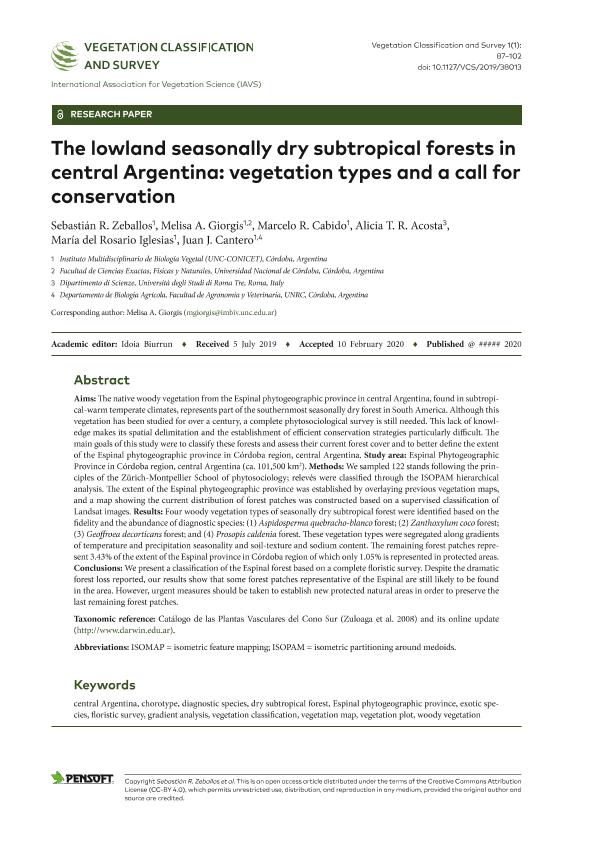Artículo
The lowland seasonally dry subtropical forests in central Argentina: vegetation types and a call for conservation
Zeballos, Sebastián Rodolfo ; Giorgis, Melisa Adriana
; Giorgis, Melisa Adriana ; Cabido, Marcelo Ruben
; Cabido, Marcelo Ruben ; Acosta, Alicia Teresa Rosario; Iglesias, María del Rosario
; Acosta, Alicia Teresa Rosario; Iglesias, María del Rosario ; Cantero, Juan Jose
; Cantero, Juan Jose
 ; Giorgis, Melisa Adriana
; Giorgis, Melisa Adriana ; Cabido, Marcelo Ruben
; Cabido, Marcelo Ruben ; Acosta, Alicia Teresa Rosario; Iglesias, María del Rosario
; Acosta, Alicia Teresa Rosario; Iglesias, María del Rosario ; Cantero, Juan Jose
; Cantero, Juan Jose
Fecha de publicación:
04/2020
Editorial:
Pensoft Publishers
Revista:
Vegetation Classification and Survey
e-ISSN:
2683-0671
Idioma:
Inglés
Tipo de recurso:
Artículo publicado
Clasificación temática:
Resumen
The native woody vegetation from the Espinal phytogeographic province in central Argentina, found in subtropical-warm temperate climates, represents part of the southernmost seasonally dry forest in South America. Although this vegetation has been studied for over a century, a complete phytosociological survey is still needed. This lack of knowledge makes its spatial delimitation and the establishment of efficient conservation strategies particularly difficult. The main goals of this study were to classify these forests and assess their current forest cover and to better define the extent of the Espinal phytogeographic province in Córdoba region, central Argentina. Study area: Espinal Phytogeographic Province in Córdoba region, central Argentina (ca. 101,500 km2). Methods: We sampled 122 stands following the principles of the Zürich-Montpellier School of phytosociology; relevés were classified through the ISOPAM hierarchical analysis. The extent of the Espinal phytogeographic province was established by overlaying previous vegetation maps, and a map showing the current distribution of forest patches was constructed based on a supervised classification of Landsat images. Results: Four woody vegetation types of seasonally dry subtropical forest were identified based on the fidelity and the abundance of diagnostic species: (1) Aspidosperma quebracho-blanco forest; (2) Zanthoxylum coco forest; (3) Geoffroea decorticans forest; and (4) Prosopis caldenia forest. These vegetation types were segregated along gradients of temperature and precipitation seasonality and soil-texture and sodium content. The remaining forest patches represent 3.43% of the extent of the Espinal province in Córdoba region of which only 1.05% is represented in protected areas. Conclusions: We present a classification of the Espinal forest based on a complete floristic survey. Despite the dramatic forest loss reported, our results show that some forest patches representative of the Espinal are still likely to be found in the area. However, urgent measures should be taken to establish new protected natural areas in order to preserve the last remaining forest patches.Taxonomic reference: Catálogo de las Plantas Vasculares del Cono Sur (Zuloaga et al. 2008) and its online update (http://www.darwin.edu.ar).Abbreviations: ISOMAP = isometric feature mapping; ISOPAM = isometric partitioning around medoids.Keywordscentral Argentina, chorotype, diagnostic species, dry subtropical forest, Espinal phytogeographic province, exotic sp
Palabras clave:
CENTRAL ARGENTINA
,
CHOROTYPE
,
DIAGNOSTIC SPECIES
,
DRY SUBTROPICAL FOREST
Archivos asociados
Licencia
Identificadores
Colecciones
Articulos(IMBIV)
Articulos de INST.MULTIDISCIPL.DE BIOLOGIA VEGETAL (P)
Articulos de INST.MULTIDISCIPL.DE BIOLOGIA VEGETAL (P)
Citación
Zeballos, Sebastián Rodolfo; Giorgis, Melisa Adriana; Cabido, Marcelo Ruben; Acosta, Alicia Teresa Rosario; Iglesias, María del Rosario; et al.; The lowland seasonally dry subtropical forests in central Argentina: vegetation types and a call for conservation; Pensoft Publishers; Vegetation Classification and Survey; 1; 4-2020; 87-102
Compartir
Altmétricas



